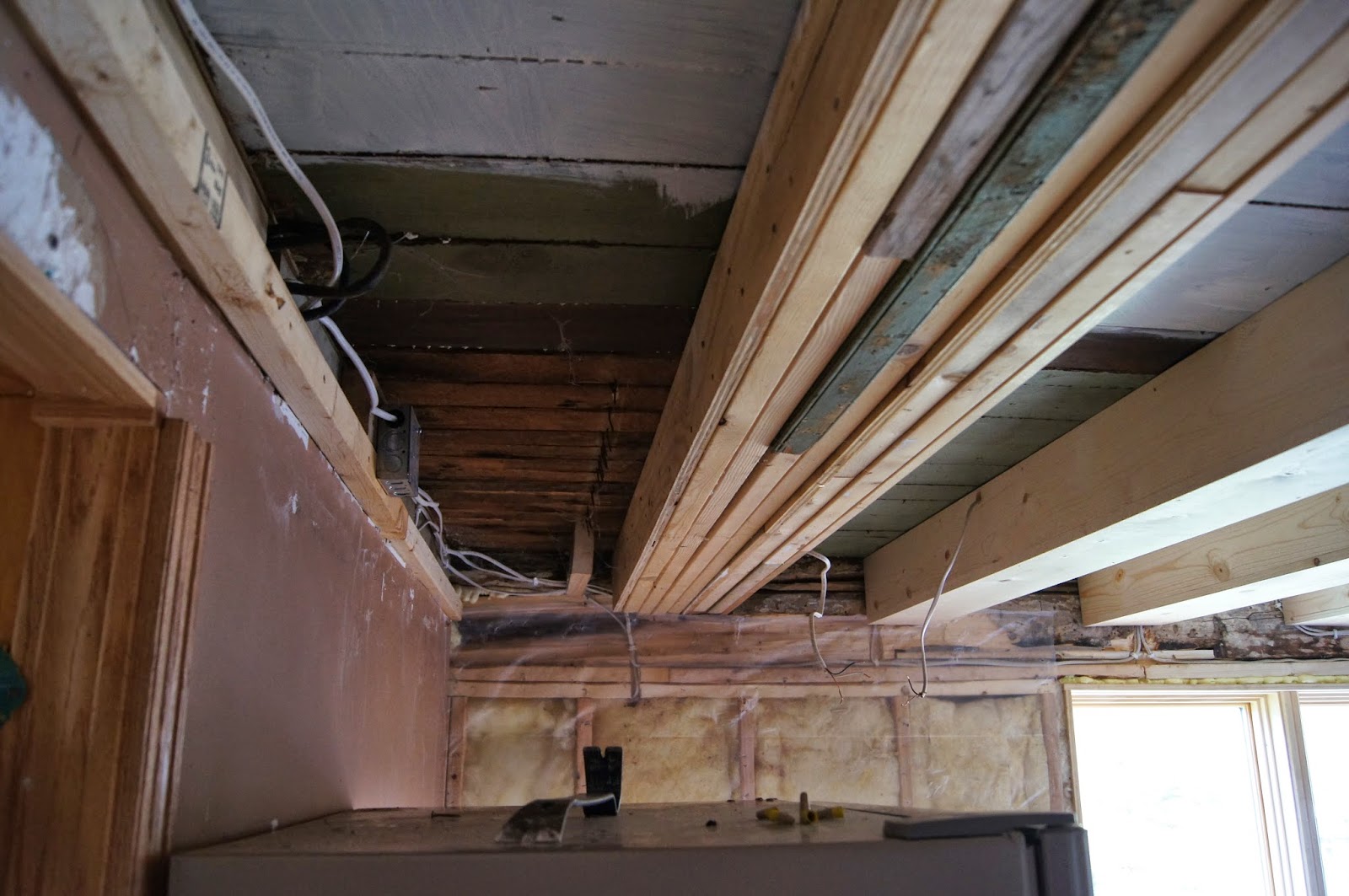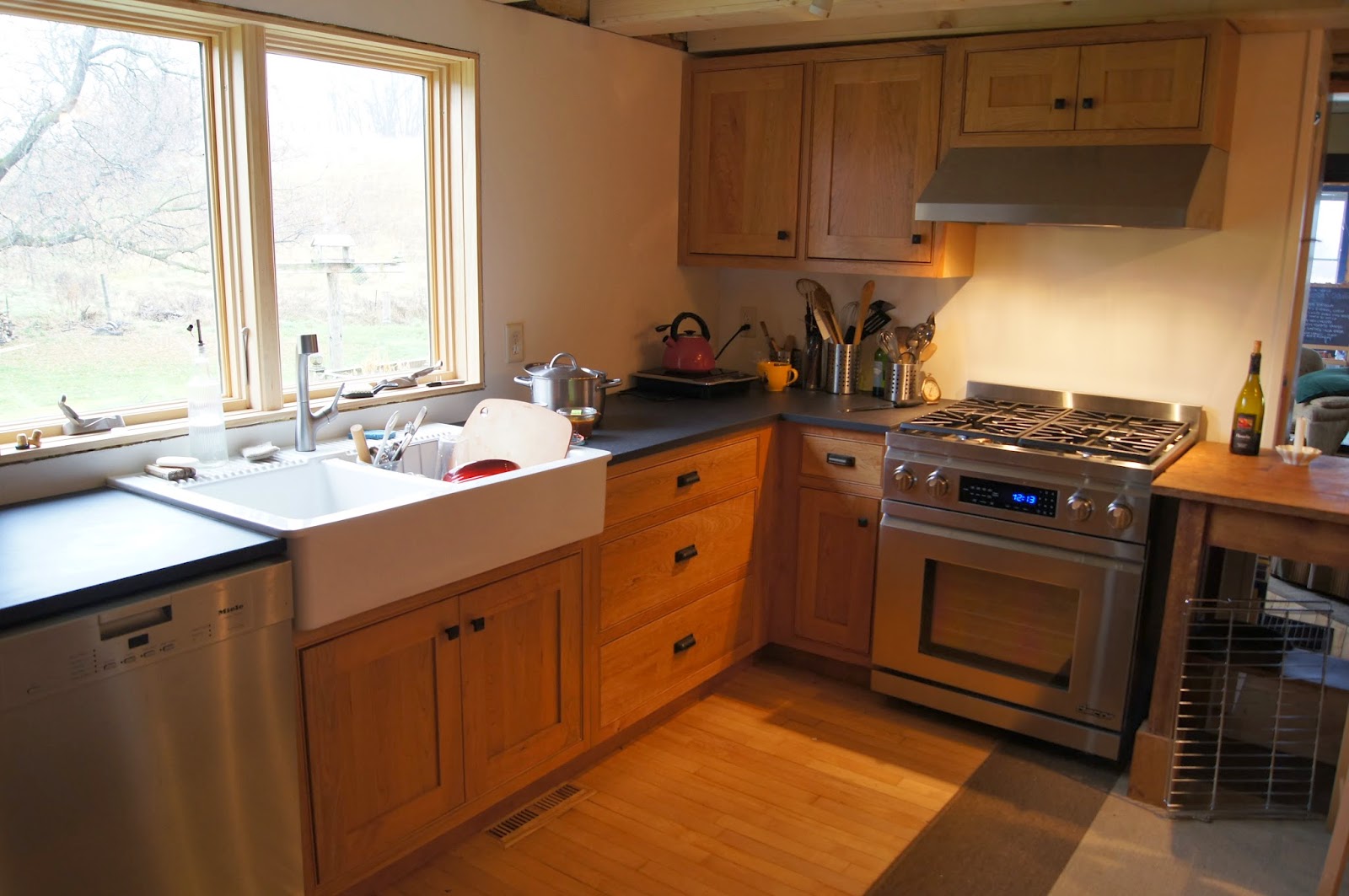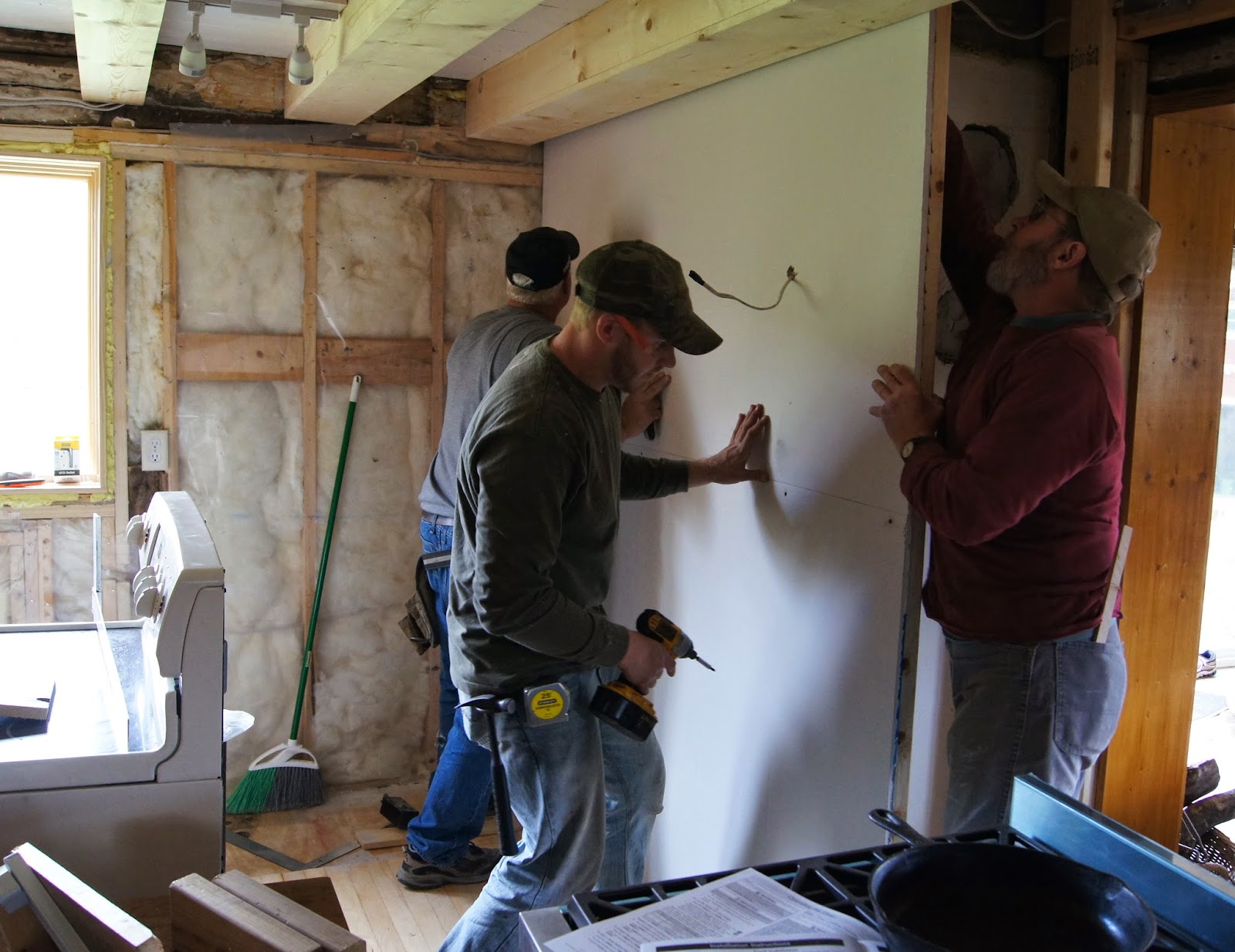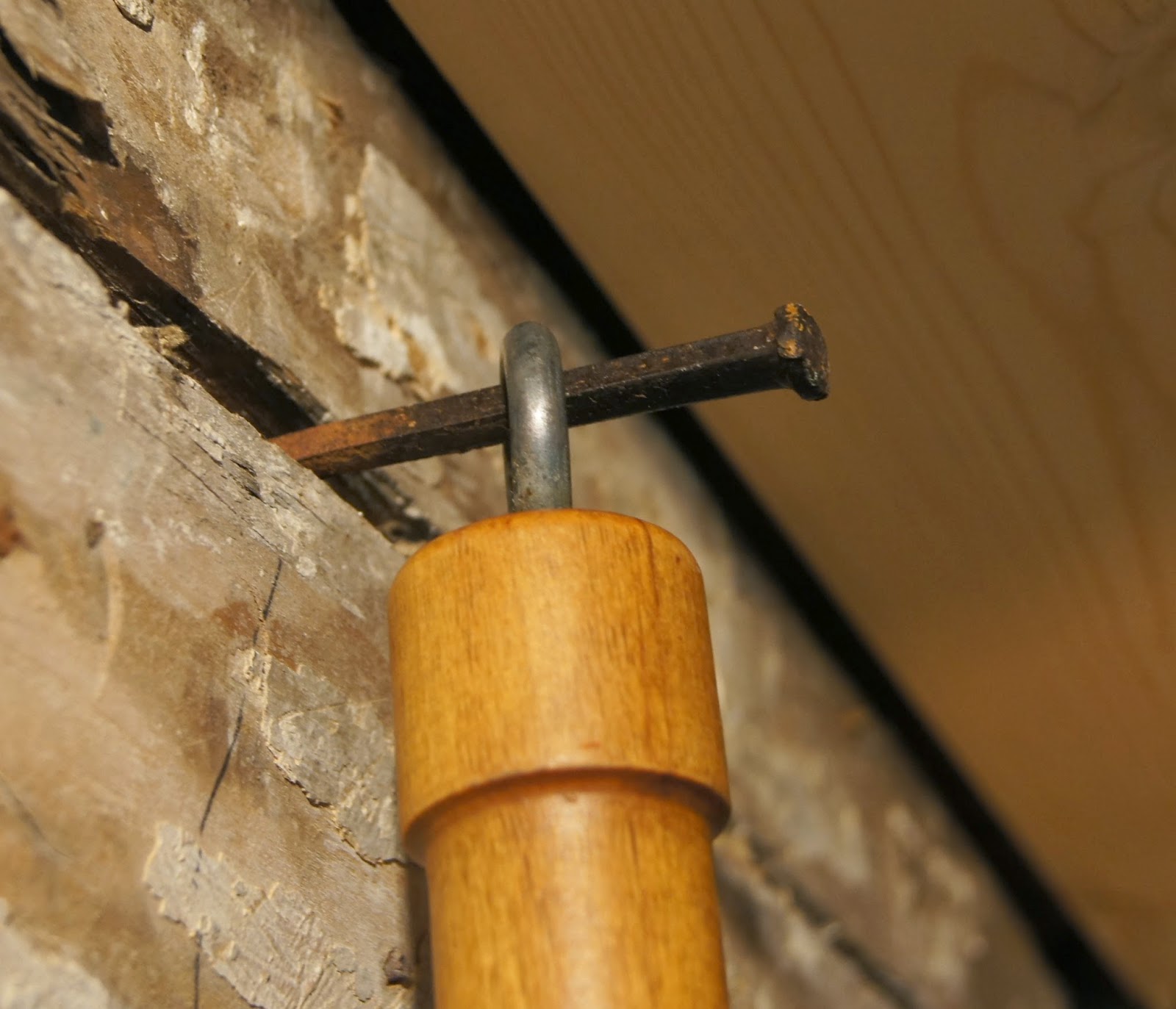We've just finished our first major kitchen renovation ever, a back-to-studs (and, in fact, logs) affair, with all new cabinets, counters, sink and faucet, and appliances--including a vent hood, which was, in a sense, the impetus for the whole thing. It started when we ripped the old drop tile ceiling down in a fit of cabin fever last winter, went into high gear late last summer, and culminated in a furious push during the first three weeks of October. All in all, it went pretty well; we only had to do dishes in the bathroom sink and bathtub for those last three weeks. We learned a lot of things we may never get to chance to apply again, and one invaluable lesson applicable in many situations, to wit: if you do your own contracting, you may find that your contractors are idiots. We did, and we did.
 |
| The old oak "chef's table" is a kind of bridge between the old and new kitchens; it was all we cared to save. |
But now that it's (mostly, except for some cosmetic touches) finished and fully functional, and I can stand in front of the big new casement window looking out on the woods and hayfield hill, and lovingly pat the chic, eco-friendly Paperstone countertops (gunmetal), see the autumn light softly burnishing the cherry cabinets, glinting dully off the international array of stainless appliances (from Germany, New Zealand, and the U.S. of A.), I feel completely happy about how it turned out, and I feel, almost, like a grown-up, almost. The day the cabinets (custom built by the awesome Bruce Schley out of Cedar Falls, but really reasonably priced) arrived, I called Mary, who was at work in the cities, and I said: Honey, we have a problem; Bruce is here with the cabinets, and they're too nice for us....
 |
| The almost original kitchen; we have the wood floor installed, replacing white vinyl, before we moved in. |
The new kitchen is especially amazing in contrast with what we inherited when we bought the house. It's a nice big room, about 15 feet square, so plenty of space to work with. But in the old kitchen everything--cabinets, sink, range--was lined up down one wall, dead-ending in a weird cul-de-sac created by a chimney, and the huge refrigerator was exiled to a distant corner of the room. The cabinets were painted a cheery red, which helped to disguise, at least for a while, the fact that the cupboard and drawer fronts were a mish-mash of "styles," to put it nicely. The best of the drawers were Menard's cheapest, and the worst featured wood-on-wood construction that resulted in a shower of fine sawdust raining down on everything in the cabinet below. The counters weren't really secured to the cabinets, making vegetable chopping and bread kneading a kind of seasick experience. The less said about the cheap electric range, where the plastic around the vent opening had melted, that kept whatever oven temp it damn well pleased, depending on its mood of the day, the better.
Indeed, enough about the bad old days. Here's a run-down of what we did, and why, in hopes that it might be useful if you're planning a kitchen re-do someday. And yeah, also just to show off, for sure.
We took kind of a total flyer on the countertops, which was crazy because they weren't cheap, and once they're there, they're there. We love them. They're Paperstone, made from recycled paper bound with some miracle resin, hard as stone! We came across them while browsing at Natural Built Home in Minneapolis. The usual stone and composite countertop materials didn't thrill us, so we went to check out the bamboo and other recycled material surfaces at Natural Built Home, and found ourselves instead drawn to the warm matte finish of the Paperstone. We contacted the company, ordered some samples, and said yeah, let's do it. Paperstone, what the hell. Our cabinet guy Bruce (a genius, did I say?) said he could cut it to size for us, so we had a 5' x 12' by 1" thick slab shipped directly to him. It weighed over 600 pounds; luckily, Bruce has a skid steer. The 60 square feet was way more than we needed, but getting the 5 x 12 sheet meant he could cut two L shapes to go on either side of the sink, so no seams. Very cool. Bruce testified to the hardness of the Paperstone material; it ruined every saw and router blade in his shop....
The sink has a story. It is from Turkey, via Ikea. Mary got interested in apron-front "farmhouse" sinks; I said, fine. I wanted white after many years of stainless sinks. The Ikea "domsjo" sink was less than half the price of similar sinks from Kohler and the like. I went to the Twin Cities Ikea to pick one up. It was out of stock, they didn't know when or if they were getting more. Could they order one from another store? No. Could I buy it online? No. Would they sell me one of the display models (there were at least three on the floor)? Negatory, good buddy. Thanks for all the help, Ikea.
Back home, I did some research and found that an Ikea store just north of Chicago, in Schaumberg, had several in stock. I called to see if I could buy it and have it shipped. Nope. Would they set one aside for me, so if we made the long drive (about 5 hours each way), we wouldn't arrive to find them sold out? Well, they could set it aside if I bought it. So, great, I'll buy it (whip out the Visa, ready to reel off the numbers). But, they can't take phone orders. For real? The mighty Ikea cannot take a credit card phone order? So they would set it aside if I bought it first, but I had to come to the store, which is, as I mentioned, just north of Chicago, to buy it. And then why would I need them to set it aside...? Thanks for all the help, Ikea!
If it seems insane to spend all day in the car just to get a kitchen sink, then you're probably someone who hasn't been through a project like this, and doesn't fully understand what I've come to call Decision Fatigue Syndrome (DFS). This is a phenomenon reached at that point in a project when so many decisions have already been made, then unmade, remade, almost made, reneged upon, reconsidered, decided again, etc., that rather than having to make a brand new decision about, say, a freaking kitchen sink, you are more than willing to spend a full day in the car, including dealing with crazy traffic on the under-construction-for-40-miles Illinois tollway. That's what DFS does to you. Driving to Chicago, at least, was a finite task, over when it was over, and no more decisions to make on that front. And yes, it was insane.
Here's an interesting thing about apron front sinks: It's not just a cosmetic difference from the usual inset sinks. There's actually a big size difference. I measured. Our old sink, a typical size from, you know, Menard's (nothing against Menard's, we're there like every other day...), measured 33 inches wide. The new sink which looks huge, is 36 inches wide. So, less than 10 per cent wider. But the area of the sink basins themselves, get this, is more than 35 per cent larger. Yes, amazing. You can do the math yourself: the old sink basins were 14" by 15", or 210 square inches per; new sink 15.5" by 18.5", about 287 square inches. The difference is very apparent when you're washing stuff up in there, very spacious. Right, enough sink geekery.
 |
| Ceiling before. |
One of the biggest conundrums we faced had to do with the ceiling, which, as I said, is where we started down the rabbit hole of deconstruction. White acoustic tiles with canister lighting, and low enough that even a shortish person could easily reach up and touch it. Oppressive. We knew it had to come down, and so, last January I think it was, with our friend Martha visiting and egging us on, we started pulling the tiles down, and then the one-by wood pieces that the tiles were attached to. We had hoped to find rustic floor joists that we could clean up, paint, and leave exposed, to give an added sense of height to the kitchen ceiling. We did find rustic floor joists--which had all been fortified with additional 2-by-6s and assorted strips of plywood glued to the old joists and also secured with a million nails. Not so attractive.
The reason for all the retrofitting is that the original floor joists are 2-by-6s on 24-inch centers; not a lot of support there. Even with all that additional wood tacked on the stiffen them, the upstairs floor feels a bit spongy in places. We consulted a couple of reliable sources for an opinion about whether we could remove some of the seemingly haphazard reinforcements, and everyone said: leave it be. Thus, covering up the joists became the only option. We enlisted our friends Mike and Pat Robertson to do that work, and they did a terrific job (they also installed the new window, and put skylights in our upstairs the summer before; they are very accustomed to cutting holes in our house). These "beams" remain somewhat unfinished. We were originally thinking to paint them, but now we're leaning toward staining them, or just giving them a clear-coat type finish.
With track lighting tucked up between the "beams," we have plenty of light without the blanket effect of typical overhead lighting. The lights above the counter are on one switch, the lights on the other side of the room on another, with dimmers on each. Dealing with the ceiling seemed one of the most daunting aspects of the projects, and it turned out splendidly, a real team effort.
The cabinets, as I said, are natural cherry with a clear satin finish. They will darken gradually. Doors and drawers are inset. They have this "soft-close" system so you close them partway, and then they close themselves the rest of the way. Nice, I said to Bruce, but can they make sawdust, like our old ones did? He said he could bring me some sawdust to sprinkle here and there, when I found myself missing the old drawers. I don't miss them, yet. Bruce's work is just exquisite; he even used cherry plywood on the cabinet backs and drawer bottoms.
We love our fridge. It's weird to write that, but it's true. It's a Fisher & Paykel, from New Zealand, counter-depth, only about 17 cubic feet but so well designed, it doesn't seem small, at all. We stumbled upon it at an appliance store in the cities.
The salesman had shown us a number of other much larger fridges, with lots of bells and whistles, and we were still undecided. He had gone to print up some information for us, and while we waited, we wandered, and found this sleek little fridge. When the salesman came back we were still admiring the F & P, and we said, Hey, what about this one? He said, Oh, that one. Nice fridge, small. I sell a lot of those to old people from Saint Paul. And we said, Dude! We are old people from Saint Paul! This is the fridge for us!
We like that the shelves go all the way across, rather than being split shelves with center brackets to impede moving things around, and that the crisper and freezer drawers come out really easily for cleaning. We like the shallow storage areas on the door, so things fit snugly and don't rattle around and fall down when you open and close the door, as they did in the old fridge. That it's not as deep as a regular fridge means you can see right to the back, so stuff is much less likely to disappear back there and turn into runaway science projects. The freezer has a shallow center drawer just for ice cubes trays, or other shallow items (the other day I froze a bunch of steamed buns in one layer, on parchment paper, before moving them into a plastic storage bag).
 |
| Mike and Pat and the Mike 2 putting up drywall. |
Dishwasher is a German Miele brand, same thing we had in Saint Paul, and we liked it, so that was an easy decision. The most interesting thing about it is that I got it by bidding in a radio auction put on by a Rice Lake station. I put in the minimum bid at 8:00 in the morning, listened to the radio for five hours, and got the dishwasher for less than half retail price. The strange thing is that this was exactly the dishwasher we were going to buy for full price, and it just happened to come up in this auction, and I think there was only one other dishwasher in the auction. So, these things happen, sometimes, I guess.
The range is a Dacor dual-fuel, meaning electric oven and gas cooktop, also replacing what we had in Saint Paul. We considered all options, knowing that we wanted dual-fuel, as I'm convinced that an electric oven is better for bread baking. The Wolf and other high-end "pro" models were a little too industrial for me, though Dacor has also gone more in that direction since we purchased our previous range, a dozen or so years ago. Also no one could really explain to me what we were getting, above and beyond the capacities of the Dacor, for the couple grand extra. Dacor sometimes gets knocked for not being that reliable, but we used our old Dacor range brutally during our Real Bread stint, and while we did have to make some repairs, it didn't seem out of line given the years of hard use it took. I am thrilled to be able to bring out the wok again, to have an oven that gets to temperature fast and accurately. The convection feature is nice, though we never really used it that much on the old range.
The door is very heavy; the whole thing is heavy, well insulated. At some level an oven is just a hot box, but I've quickly rediscovered that not all hot boxes are created equal.
And finally, one of the coolest things that happened in the course of making our kitchen all shiny and new was discovering, and uncovering, its original bones. We had gradually become aware that the nucleus of our house was an old log cabin, probably built in the late 1800s. As we started removing drywall in the kitchen, it became clear that this room was that cabin. On the east, outside wall, we found that the logs had been mostly removed and replaced with a 2-by-6 stud wall, leaving just the topmost log as a support beam. On the interior west and south walls, the old logs were still there. They're partially coated with what looks like flaking whitewash. There are, for some reason, a million small nails pounded into them. Most of the chinking is gone.
In the southwest corner of the room, you can see where the notched logs meet, forming a kind of pillar, and that, amazingly enough, is what is still holding our house up to this day. In the course of the deconstruction we removed and saved a few old, square-cut nails from the ceiling. I smacked a couple of these into cracks in the logs, and used them to hang our cast-iron pans and the wok (which has come out of retirement now that we have gas to cook over again, hooray!).
Overall, though there were stressful moments, and the whole thing unfolded over many months, the period of real inconvenience was fairly brief, and the results are beyond all expectations. We need to pick up some cherry trim from Bruce for the window and a door frame, and do a few more finishing touches. We've been slowed down on that because, just as the final practical work was being done, the plumber connecting the sink and dishwasher, and running gas to the kitchen for the range, I got sick, and Mary followed suit, as if, with the final decisions and purchases made, and no more phone calls to coordinate and schedule all the various aspects of the work, we let our defenses down, and germs rushed in.... At least we had a really nice place to cook up a pot of chicken broth to comfort our sniffles and sore throats.
 |
| I made this! This new, yet rustic (thanks to my rustic woodworking skills) shelf unit tucks in along the side of the wood furnace chimney. |
 |
| Looking from the new to the old; also note volunteer squash/pumpkin harvest on counter in messy laundry room.... |
Text and photos copyright 2014 by Brett Laidlaw














